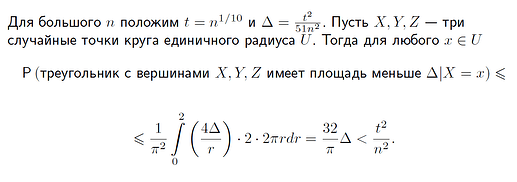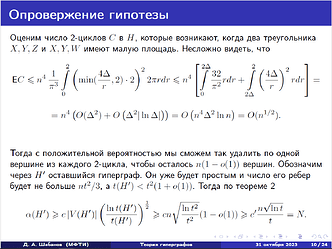@Anton, I understand your quest for a precise understanding of these calculations without resorting to approximations. Let us delve deeper into the geometry and probability involved.
Firstly, you are correct to question the range of the inscribed angle \theta. Indeed, when considering the arc subtended by the chord that forms the base of the triangle with the third point being on the circumference, the inscribed angle \theta can range from 0 to \pi, not 2\pi, since the triangle’s vertices lie on a circle, not in the entire space around the circle.
Now, let us consider the area A of a triangle inscribed in a circle (circumradius R=1 for a unit circle) with vertices X, Y, Z and the corresponding opposite sides of lengths a, b, c. Using the inscribed angle theorem and the formula for the area of a triangle given by A = \frac{1}{2}bc\sin(A), where A is the angle at vertex X opposite side a, we can express the area in terms of the inscribed angle \theta subtended by side a at the circle’s center. Since in a unit circle the chord length a is equal to 2\sin\left(\frac{\theta}{2}\right), we can write the area of the triangle as
A = \frac{1}{2}bc\sin(A) = \frac{1}{2}a\sqrt{1-\left(\frac{a}{2}\right)^2} = 2\sin\left(\frac{\theta}{2}\right)\sqrt{1-\sin^2\left(\frac{\theta}{2}\right)}.
Now, let’s define A as the event that the area of the triangle is less than or equal to \Delta, and let’s try to calculate the probability of A by integrating over the space of all possible positions of Y and Z given that X is fixed. The positions of Y and Z can be defined by their respective angles \phi_Y and \phi_Z on the unit circle.
The area of the triangle is maximized when Y and Z are at opposite ends of a diameter, which corresponds to an inscribed angle \theta = \pi. As \theta decreases from \pi to 0, the area decreases. Therefore, the condition that the area is less than \Delta imposes a maximum on \theta.
To find the probability P(A \leq \Delta), one would integrate the probability density function of the positions of Y and Z over the region of the unit circle that satisfies the area condition. However, the exact setup of the integral will depend on the precise relationship between \theta and the area of the triangle, and it will require integrating over the joint distribution of \phi_Y and \phi_Z while considering the condition on the area.
The term \frac{4\Delta}{r} cannot be derived without a clear understanding of the relationship between r and the area of the triangle, as well as the distribution of r itself. The probability density function for r would depend on the geometry of the circle and the conditions imposed by the problem.
For a rigorous derivation, one must start from the fundamental definitions of probability and geometry and perform the integration over the appropriate space, taking into account all constraints. The integral you presented would emerge from this process if the setup and the constraints are correctly applied. To aid in this rigorous derivation, consider the following:
- The probability density function for the angle \phi of a point on the unit circle is uniform over [0, 2\pi].
- The relationship between the angle \theta and the area A of the triangle must be defined precisely.
- The limits of integration and the variables of integration must be chosen to reflect the range of possible positions for Y and Z that result in an area less than or equal to \Delta.
Therefore, a precise calculation would involve setting up the integral over the entire space of angles \phi_Y and \phi_Z that correspond to triangles with an area less than \Delta, considering the relationship between \theta and A, and integrating the probability density function over this space. This is a non-trivial task that would require careful geometric analysis and integration over a potentially complex region.
To embark on this rigorous derivation, I encourage you to start by mapping out the space of all possible triangles on the unit circle and identifying the constraints imposed by the area condition. Then, set up the integral over this space and solve it to find the desired probability. This process will deepen your understanding of the relationship between geometry and probability in this context.


